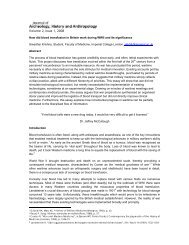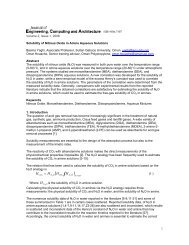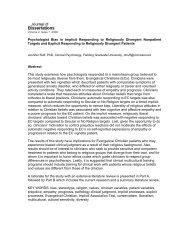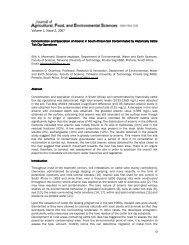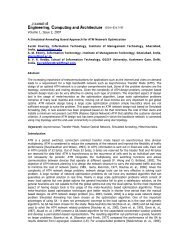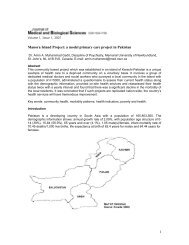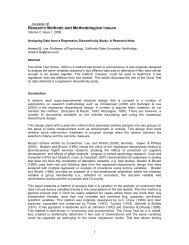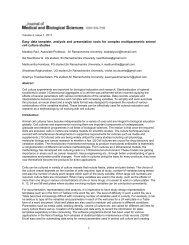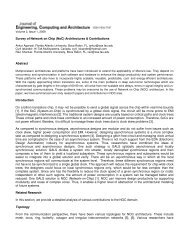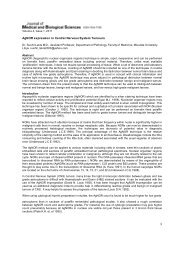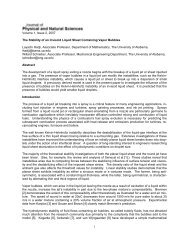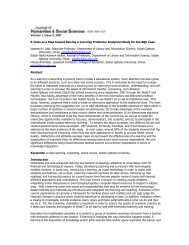The Heaven and Earth Society and the Red Turban Rebellion in ...
The Heaven and Earth Society and the Red Turban Rebellion in ...
The Heaven and Earth Society and the Red Turban Rebellion in ...
You also want an ePaper? Increase the reach of your titles
YUMPU automatically turns print PDFs into web optimized ePapers that Google loves.
<strong>the</strong> Q<strong>in</strong>g dynasty marked <strong>the</strong> genre's most fruitful period. County gazetteers (xianzhi 縣 志 ) from Guangdong<br />
are particularly useful for my study, as <strong>the</strong>y provide <strong>the</strong> most detailed local <strong>in</strong>formation. Thanks to <strong>the</strong> efforts<br />
of <strong>the</strong> history department of Zhongshan University, most of memorials as well as local gazetteers, on <strong>the</strong><br />
subject of <strong>the</strong> <strong>Red</strong> <strong>Turban</strong> <strong>Rebellion</strong>s are now collected <strong>and</strong> published under <strong>the</strong> title of Guangdong<br />
hongb<strong>in</strong>g qiyi shiliao 廣 東 洪 兵 起 義 史 料 (1992). 6 Besides <strong>the</strong>se sources, I also consulted several biographies<br />
<strong>and</strong> scholarly works of <strong>the</strong> time not <strong>in</strong> <strong>the</strong> Guangdong hongb<strong>in</strong>g qiyi shiliao, such as <strong>and</strong> <strong>the</strong> Sohak<br />
dongjumki 西 學 東 漸 記 , <strong>the</strong> biography of a gentry member who was travel<strong>in</strong>g <strong>in</strong> <strong>the</strong> Guangzhou area dur<strong>in</strong>g<br />
<strong>the</strong> chaotic mid-n<strong>in</strong>eteenth century. 7 <strong>The</strong> last primary sources I have used are <strong>the</strong> writ<strong>in</strong>gs of n<strong>in</strong>eteenthcentury<br />
foreigners <strong>in</strong> <strong>the</strong> central Guangdong area, <strong>in</strong>clud<strong>in</strong>g tourists' accounts, Consular Reports, <strong>and</strong>, <strong>in</strong><br />
particular, reports from missionaries. 8<br />
F<strong>in</strong>ally, a note about conventions. First, I use P<strong>in</strong>y<strong>in</strong> Romanization throughout. Second, with regard<br />
to place names, I have tried to use <strong>the</strong>ir late imperial forms, with a preference whenever possible for <strong>the</strong> ca.<br />
1850 forms. Also, although <strong>the</strong>re were various names (xiang, t<strong>in</strong>g, etc.) for <strong>the</strong> lowest-level political unit <strong>in</strong><br />
<strong>the</strong> late imperial state, I translate all as “county.”<br />
2) Ti<strong>and</strong>ihui<br />
<strong>The</strong> orig<strong>in</strong> of <strong>the</strong> Ti<strong>and</strong>ihui has been a subject of cont<strong>in</strong>u<strong>in</strong>g concern for Ch<strong>in</strong>ese historians of <strong>the</strong><br />
twentieth century. Accord<strong>in</strong>g to Dian Murray’s research, “it was generally agreed that <strong>the</strong> organizations<br />
called <strong>the</strong> Ti<strong>and</strong>ihui, <strong>the</strong> Three Dots <strong>Society</strong> (S<strong>and</strong>ianhui 三 點 會 ), <strong>the</strong> Three United <strong>Society</strong> (Sanhehui<br />
三 合 會 ), <strong>the</strong> Hong League (Hongmen 洪 門 ), <strong>and</strong> <strong>the</strong> Triads were one <strong>and</strong> <strong>the</strong> same, it was impossible to<br />
verify <strong>the</strong> po<strong>in</strong>t.” 9<br />
Even though <strong>the</strong> actual orig<strong>in</strong>s of <strong>the</strong> Ti<strong>and</strong>ihui are still clouded <strong>in</strong> obscurity <strong>and</strong> much heated<br />
scholarly debate, it is clear that <strong>the</strong> spread of <strong>the</strong> Ti<strong>and</strong>ihui was accelerated by Monk Ti Xi 提 喜 at Zhangpu<br />
漳 浦 county, Zhangzhou 漳 州 prefecture of Fujian 福 建 prov<strong>in</strong>ce <strong>in</strong> <strong>the</strong> eighteenth century, <strong>and</strong> that as a<br />
product of popular culture with deep social roots, it grew out of <strong>the</strong> natural configurations of Ch<strong>in</strong>ese society<br />
<strong>in</strong> places where <strong>the</strong> ecological <strong>and</strong> economic crises were most acute. 10 Monk Ti Xi recruited three fellow<br />
residents of Zhangpu county: Lu Mao 盧 茂 , Li Am<strong>in</strong> 阿 閔 (alias Li Shaom<strong>in</strong> 少 敏 ), <strong>and</strong> Fang Quan 方 權 .<br />
In acknowledg<strong>in</strong>g Ti Xi as <strong>the</strong>ir leader, <strong>the</strong>se men became <strong>the</strong> first generation of Ti<strong>and</strong>ihui “bro<strong>the</strong>rs” who,<br />
dur<strong>in</strong>g <strong>the</strong> Qianlong 乾 隆 period (1711-1799), spread <strong>the</strong> society throughout <strong>the</strong> rema<strong>in</strong>der of Zhangpu <strong>and</strong><br />
P<strong>in</strong>ghe 平 和 counties, Fujian, <strong>and</strong>, through <strong>the</strong>ir disciples, across <strong>the</strong> strait to Taiwan. <strong>The</strong> followers of <strong>the</strong>se<br />
6 Guangdong hongb<strong>in</strong>g qiyi shiliao 廣 東 洪 兵 起 義 史 料 , Guangdong sheng wenshi yanjiuguan, Zhongshan<br />
daxue lishi xibian (Guangzhou : Guangdong renm<strong>in</strong> chubanshe, 1992).<br />
7 Yong Kweng 容 閎 , Sohak dongjumki 西 學 東 漸 記 , trans. Kwon Heechul (Seoul: Ulyumoonhwasa, 1974).<br />
8 Most of <strong>the</strong>se sources were scattered <strong>in</strong> church publications such as <strong>The</strong> Ch<strong>in</strong>ese Review <strong>and</strong> <strong>The</strong> Ch<strong>in</strong>ese<br />
Recorder <strong>and</strong> <strong>in</strong> <strong>the</strong> twenty volumes of <strong>the</strong> Ch<strong>in</strong>ese Repository <strong>and</strong> <strong>in</strong> <strong>the</strong> British Foreign Office file <strong>in</strong> <strong>the</strong><br />
Public Record Office, London.<br />
9 This perception of <strong>the</strong> Ti<strong>and</strong>ihui as a nationalist political organization is still deeply cherished by scholars<br />
on both Taiwan <strong>and</strong> <strong>the</strong> Ch<strong>in</strong>ese ma<strong>in</strong>l<strong>and</strong>. See Dian H. Murray, <strong>in</strong> collaboration with Q<strong>in</strong> Baoqi. <strong>The</strong><br />
Orig<strong>in</strong>s of <strong>the</strong> Ti<strong>and</strong>ihui <strong>the</strong> Ch<strong>in</strong>ese Triads <strong>in</strong> Legend <strong>and</strong> History (Stanford: Stanford University Press,<br />
1974), Introduction <strong>and</strong> chapter 4.<br />
10 Western archival scholars such as Dian Murray <strong>and</strong> David Ownby do <strong>the</strong> recent important studies on <strong>the</strong><br />
orig<strong>in</strong>s of <strong>the</strong> Ti<strong>and</strong>ihui. Murray, especially <strong>in</strong> her work, <strong>The</strong> Orig<strong>in</strong>s of <strong>the</strong> Ti<strong>and</strong>ihui, argued that Monk Ti<br />
Xi created <strong>the</strong> Ti<strong>and</strong>ihui <strong>in</strong> 1761 or 1762. But this is still a problematic argument s<strong>in</strong>ce ano<strong>the</strong>r group of <strong>the</strong><br />
Ti<strong>and</strong>ihui members, such as Ma Jiulong 馬 九 龍 , were active <strong>in</strong> Guangdong before Ti Xi’s Ti<strong>and</strong>ihui <strong>in</strong><br />
Fujian. <strong>The</strong> fact that Lu Mao, a disciple of Ti Xi, met Li Hao 浩 , a Ti<strong>and</strong>ihui member from ano<strong>the</strong>r<br />
branch of <strong>the</strong> Ti<strong>and</strong>ihui, on his way to north of Fujian prov<strong>in</strong>ce after his failure of upris<strong>in</strong>g <strong>in</strong> 1768, also<br />
<strong>in</strong>dicates <strong>the</strong> existence of <strong>the</strong> Ti<strong>and</strong>ihui before Ti Xi. As Zhuang Jifa has po<strong>in</strong>ted out that <strong>the</strong> Ti<strong>and</strong>ihui did<br />
not created by any particular person but it had slowly evolved from <strong>the</strong> tradition of multi-surname<br />
bro<strong>the</strong>rhoods that were organized for mutual-assistance. See Wu Zhaoq<strong>in</strong>g 吳 兆 淸 <strong>and</strong> Hao Zhiq<strong>in</strong>g<br />
赫 治 淸 , Zhongguo banghuishi 中 國 幇 會 史 (Taibei: Wenzhi chubanshe, 1996), 62-64; Zhuang Jifa 莊莊 吉 發 ,<br />
Q<strong>in</strong>gdai Ti<strong>and</strong>ihui yuanliukao 淸 代 天 地 會 原 流 考 (Taibei: Shil<strong>in</strong>, 1982), 4-18; David Ownby,<br />
Bro<strong>the</strong>rhoods <strong>and</strong> Secret Societies <strong>in</strong> Early M<strong>in</strong>g-Q<strong>in</strong>g Ch<strong>in</strong>a; <strong>The</strong> Formation of A Tradition (Stanford:<br />
Stanford University Press, 1996).<br />
3



